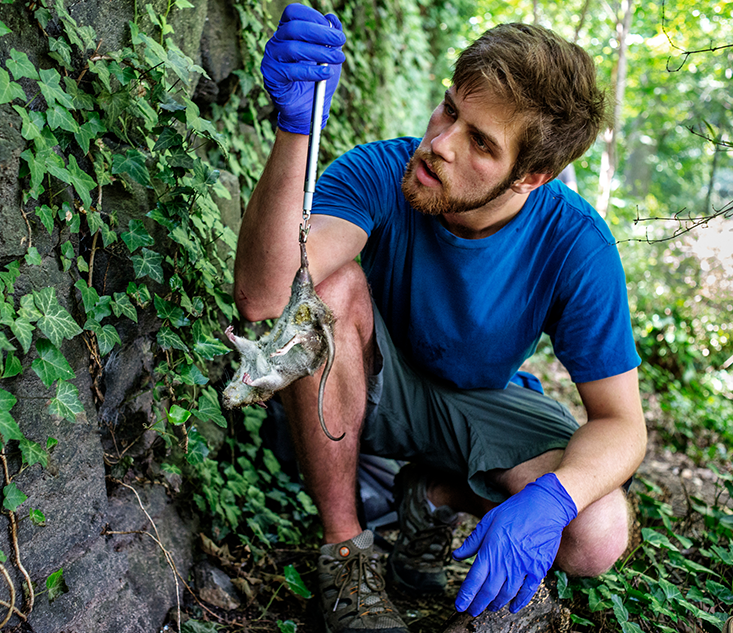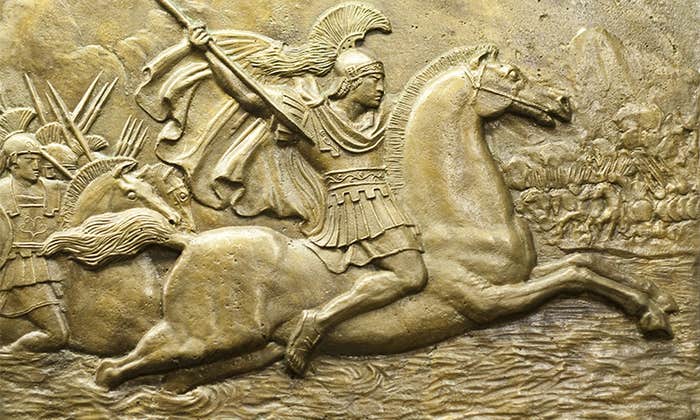The good thing about studying rats is you don’t have to travel very far. Fordham University evolutionary biologist Jason Munshi-South studies biodiversity and evolution right here in New York City. His study subjects—rats and mice—are abundant here.
Munshi-South thinks of the city as a grand evolutionary experiment. When he looks at a map of New York City, he sees the city’s parks and green spaces as wildlife islands. Movement within islands is free, but between islands is restricted.
White-footed mice, for example, thrive in city parks but not on concrete and asphalt. Munshi-South can tell which park a mouse is from, and how it moves around the city, from its genetic code. Central Park mice, he’s found, are relatively isolated. Mice from Van Cortlandt Park and the other parks in the Bronx, where there are more trees and shrubbery, move a bit more freely.
It’s necessary to understand what cities are doing if we really want to understand ecology and evolution.
A few hundred years of the city’s history—during which time parks were constructed and then isolated from each other—is inscribed in mouse DNA this way. Studying rodent evolution in a changing urban environment allows him to glimpse evolution in real time, within the span of a scientific career.
In a conversation with Nautilus, Munshi-South tells us more about New York City’s signature rodents.

You call evolution of wildlife in New York City a grand evolutionary experiment. Why?
We have created these environments for ourselves to meet our needs, but then we also have all these other species that we brought here or that were already in the region and have come to inhabit the city. We have created essentially novel pressures on those organisms and they have to find ways to adapt or be extirpated from the city. This is something that has happened very rapidly—our cities have developed very quickly over the last few hundred years, especially in North America.
I don’t think the white-footed mice in Central Park really get out of that park very often.
This is almost evolution in real time. It gives us a powerful sort of backyard study system to look at the basic forces of evolution within the span of a scientific career. I think urbanization and cities are particularly interesting because there are so many cities and we’re seeing the same processes play out almost in replication. You almost have a replicated experiment taking place across the globe.
Cities occupy only a small part of the landscape, but their pressure on surrounding areas is immense, and so cities have become one of the major forces or drivers of lots of processes, at least on a regional scale. It’s necessary to understand what cities are doing if we really want to understand ecology and evolution as it operates now. Because so many people live in cities, it’s also useful from an educational and societal viewpoint. It’s the nature that people experience, and they want to know more about it.
By looking at the genetic variation in mice, can you tell how mice move through the city?
We use genetic data to estimate how much gene flow there is between parks, basically how many individuals are moving per generation and spreading their genes. We build models of how we think white-footed mice and other species would move through the city, and test those models against the genetic data to see which ones are best predictive of movement.
We found that white-footed mice movement tracks vegetation and canopy cover. This has a lot of implications if you want to influence animal movement; if you don’t want animals spreading disease, or maybe you want to make populations to flourish in the city. You could potentially do that by changing the composition of green space in the city.

So are the Central Park mice, for instance, isolated from those in parks farther north?
Yes, I don’t think the white-footed mice in Central Park really get out of that park very often. In some of the other areas of the city, they do move around more. They seem to be able to get in and out of the big parks in the Bronx better. And some of the parks in eastern Queens. Those are the greener, less developed parks of the city.
Is the history of New York City inscribed in the genes of mice?
Partially, yes. We can imagine before Europeans the mice were everywhere, moving around. As Europeans developed New York City and southern Manhattan, and then agricultural areas everywhere else, the mice were probably still moving around for the most part through agricultural areas. But once you got to heavy urbanization of Manhattan about 150 years ago, and of the other boroughs about 120 years ago, in a matter of a few decades these parks were developed and became quite isolated.
We can use the genetics to date when populations became isolated. The dates are rough because we have to make some assumptions, but they do coincide with the history of urbanization in New York City. So that history is written into the genes of some of these animals.
Do rats follow green corridors like mice?
That’s actually what we’re studying now. One of our hypotheses is that rats love to burrow in green space, and that will contribute to their genetic structure and how they move around. We also think sewers are important. The other hypothesis that we have has to do with the socioeconomic landscape of New York City. Where you have large concentrations of lower-income people and old housing stock that may not be taken care of very well, we think that will contribute to where rats are and where they move around and where there are source populations.
What is the rat-trapping process like?
It’s pretty easy. I’m sure you’ve seen the black bait boxes everywhere in New York City that say “Poison. Do Not Touch”? [Each trap is a] black plastic box, somewhat triangular, and usually it has poison in it, but we put a baited trap inside it.
There’s this huge cluster of rats around the world that are all very closely related.
Sometimes we keep the whole rat. Sometimes we just cut off some of the tail for genetics. When we take the whole rat, we’re usually collecting other materials to test for disease, or we’re saving the skulls to study morphological variation in the rats. We’re building a reference collection at the Peabody Museum of Natural History at Yale of rat skulls and also white-footed mice to understand changes over time and between cities.
Our initial strategy was to try to get rats from every zip code as kind of a heuristic for dividing up the city. There’s 40-something zip codes in Manhattan. They’re all pretty small, and if you can get rats from each one of them, then you’ve covered pretty much all of Manhattan.
Are rats adapting to become better urban dwellers?
That’s also an ongoing study. We’ve sequenced about 40 whole genomes from New York City rats—the whole sequence is about 2.7 billion base pairs of DNA. We’ve been looking for signatures of selection in those genomes and have found quite a few, and we’re still sorting through those results.
But the main hits so far are in the odor receptor genes. That’s perhaps not surprising, because rats have a lot of odor receptors. They have three times more than humans, and they’re very smell driven. It’s likely that in New York City they are adapting to a different odor landscape.
Rats have probably been in New York City from about the 1750s, at the earliest. Over the last few hundred years, they’ve adapted to a growing city and now they live in different places than they used to. They use sewers and subways. They’re getting all sorts of food, so there are lots of reasons why they would benefit from variation in odor receptors that allows them to exploit this novel environment better.
The big unknown question right now is whether this is something that happens to rats every time they get to a new place and to what extent is this unique to New York City.
What does your recent study tell us about where city rats come from?
We wanted to understand where New York City rats came from and when they got here. I started contacting colleagues around the world and asking them for samples of rats from their respective locations. We took these samples and generated genome-like data from about 30,000 locations for each sample.
We looked at how all these rats were related to understand patterns of how they moved around. There seems to be a kind of center of diversity in Asia, which is where they evolved, and then an initial expansion into southeast Asia then a slow movement across Eurasia into Europe. Rats really got out everywhere else from western Europe during the colonial period. That’s when they arrived in New York City. The New York City rats show a very close genetic similarity to rats from Great Britain and other cities on the east coast like Baltimore, and Brazil even.
There’s this huge cluster of rats around the world that are all very closely related because they spread around from a few source populations very quickly. Then you have these much more diverse populations in Asia. The one place that was really interesting and we’re still working to understand this is Alaska and western North America. What seems to be the case is that there were rats that moved across North America from east to west. You see them mixing on the west coast with ancient lineages of rats that were moved into Alaska, probably moved around by Russian fur trappers and later colonists that came from Asia.
Katherine Walter is an editorial fellow at Nautilus.






























